#Apristurus
Explore tagged Tumblr posts
Text
THREE NEW SHARK SPECIES THIS WEEK!
The second week of July 2023 something extraordinarily beautiful happened, the findings of 3 new species of sharks for were announced
A new angel sharks species was identified, from the western Indian Ocean on the Mascarene Plateau and off southwestern India in 100–500 m depths, the Lea’s angel shark Squatina leae, was recognized to be different genetically and morphologically distinct from its congeneric species Squatina africanae, following unique morphological features. This species was first detected in 1988 after finding three unusual, small sharks, but till today was completely understood. The angel shark is named after one of the author’s fiancee’s late sister, Lea-Marie Cordt.
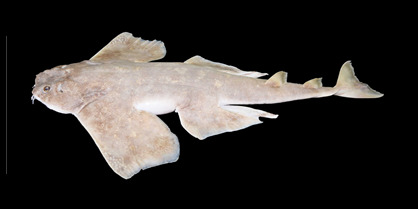
- Squatina leae, adult male, in dorsolateral.
Angel sharks are “flatter sharks”, possesing distinctly broad, dorsoventrally flattened bodies, a short snout with large mouth and nostrils, eyes on top of the head close to the large spiracles, very large pectoral fins, and a lateral caudal keel. They've evolved to be ambush predators, they lie in wait for prey to pass closely overhead before attacking.
Reference (Open Access): Weigmann et al., 2023. Revision of the Western Indian Ocean Angel Sharks, Genus Squatina (Squatiniformes, Squatinidae), with Description of a New Species and Redescription of the African Angel Shark Squatina africana Regan, 1908. Biology
From North Australia, another species of hornshark is described based on six whole specimens and a single egg case. The painted hornshark Heterodontus marshallae was previously considered to be the same with the zebra bullhead shark another well know bullhead shark from the central Indo-Pacific from Japan to Australia, but genetic and morphological analyses indicated the sharks were different, but looking alike. The painted hornshark is endemic to northwestern Australia and occurs in deeper waters, at 125–229 m below surface.
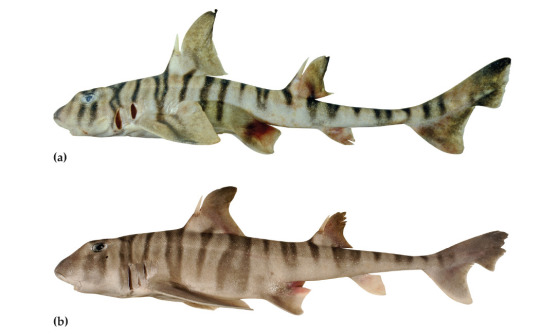
- Lateral view of two mature female painted hornshark Heterodontus marshallae showing small differences between individuals
The painted hornsharks is named in honour of Dr. Lindsay Marshall www.stickfigurefish.com.au a scientific illustrator and elasmobranch scientist who expertly painted all the sharks and rays of the world for the Chondrichthyan Tree of Life Project.
Reference (Open Access): White et al., 2023 Species in Disguise: A New Species of Hornshark from Northern Australia (Heterodontiformes: Heterodontidae). Diversity.
And from an unidentified shark egg collected from the deep waters of northwestern Australia, in 2011 recently helped researchers identify a new species of deep water cat shark. Called ridged-egg catshark Apristurus ovicorrugatus after its eggs, it was collected in the earlys 90 but remained unknown to date. This sharks presents white eyes, and is small in size, reaching less than a half meter in length. .
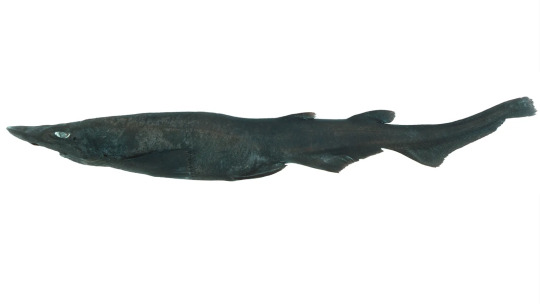
- Lateral view of female Apristurus ovicorrugatus before preserved. Photo by CSIRO.
Egg cases belonging to this species had been documented as early as the 1980s, but could not be matched to any species of Australian shark until recently scientists examined a shark specimen of previously uncertain identity in the CSIRO collection.
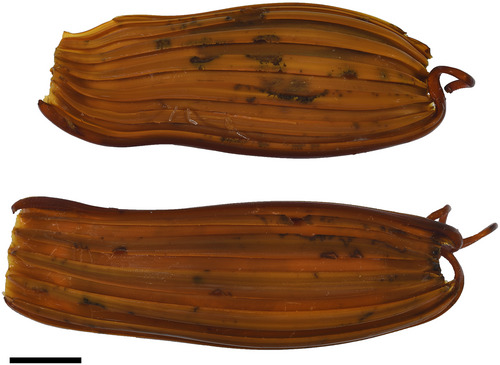
-egg cases of Apristurus ovicorrugatus. Scale bar is 10 mm
Reference (Open Access) White,et al., 2023 What came first, the shark or the egg? Discovery of a new species of deepwater shark by investigation of egg case morphology. Journal of Fish Biology.
#Squatina leae#Squatina#new species#elasmobranch#shark#biology#marine biology#science#marine science#indian ocean#bioblr#sciblr#sci#painted hornshark#Heterodontus marshallae#Heterodontus#Apristurus ovicorrugatus#Apristurus#long post#Ridged-egg catshark#Lea’s angel shark
3K notes
·
View notes
Text
Alone in the world is a little catshark 🦈
This is one of the three deep-sea catshark species found in the Northeast Pacific, the longnose catshark, Apristurus kampae. They are found at depths ranging from 180 to 1,888 meters (590 to 6,500).
Catsharks are bottom feeders and are most active at night, often sleeping in groups during the day and hunting at night.
335 notes
·
View notes
Text
#eukarya#animalia#chordate#chondrichthyes#elasmobranch#selachimorpha#hexanchiformes#hexanchidae#notorhynchus cepedianus#hexanchus griseus#squaliformes#squalidae#squalus suckleyi#Apristurus brunneus#carcharhiniformes#scyliorhinidae#brown Catshark#Pacific Spiny Dogfish#broadnose Sevengill Shark#bluntnose sixgill shark#poll#pnw#puget sound
2 notes
·
View notes
Text

This is the new shark species
identified from museum specimens which is hilarious to me because they had these egg cases and only now figured out that a misclassification occurred
it’s a demon/ghost catshark!
108 notes
·
View notes
Text
Shark of the day 2:
Shortbelly Catshark
The shortbelly catshark (Apristurus breviventralis) is a catshark of the family Scyliorhinidae. It is found in Gulf of Aden, Indian Ocean. This species most closely resembles the western Atlantic species Apristurus canutus, but is distinguishable in having greater nostril length than internarial width and longer claspers in adult males.

47 notes
·
View notes
Text
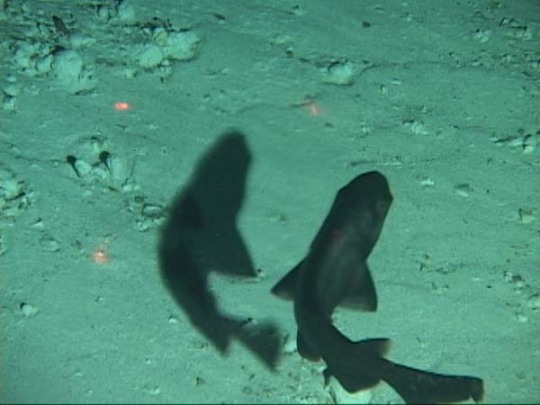
Spongehead catshark | Apristurus spongiceps
Fun fact: the spongehead catshark has only three official reports: two specimens, an adult female and a juvenile, as well as the above image taken by the Pisces IV in 2002
Photo credit: x
52 notes
·
View notes
Photo

Hiu berjumbai (Chlamydoselachus anguineus) atau Frilled Shark dalam bahasa inggris merupakan salah satu dari dua spesies ikan hiu yang masih ada di keluarga Chlamydoselachidae dengan distribusi yang luas tapi tidak merata di samudra atlantik dan samudra pasifik. . Mereka ditemukan dikedalaman 1.570 meter, sedangkan di teluk surugaya jepang hiu ini paling umum ditemukan pada kedalaman 50-200 meter. . Namun pada tahun 2009 jenis baru hiu berjumbai di afrika selatan, dan pada bulan november 2017 baru-baru ini hiu tersebut terdampar di pantai di portugal. . hiu ini merupakan penghuni laut dalam yang menyebabkan metabolisme tubuh hiu ini menjadi lemah karena suhu yang sangat dingin diperairan dalam. . Perairan dalam ini pula yanng menyebabkan memiliki bentuk fisik yang unik, hiu berjumbai telah tercatat dari sejumlah lokasi di samudra atlantik dan pasifik, yaitu di atlantik timur di norwegia, di utara skotlandia, irlandia barat, dari Prancis hingga ke maroko termasuk madeira dan luar mauritania. . panjang rahang hiu berjumbai sangat bisa dibedakan dengan kelenturan yang sangat lebar, sehingga memmungkinkan untuk menelan mangsa utuh lebih dari setengah ukuran nya, hiu ini biasa memangsa cumi-cumi, ikan, hiu lain yang berukuran kecil seperti hiu kucing jepang (Apristurus japonicus). . Sc image: Australian Geographic Sc caption: Wikipedia ============================================ Kunjungi kanal Enigma Hitam di YouTube untuk konten video misteri, konspirasi, sejarah, mitologi, creepypasta dan lainnya. . Follow instagram ini untuk mendapatkan kasus atau kisah menarik lainnya ⬇ ❓ @enigmahitam ❔ ❓ @enigmahitam ❔ . #enigmahitam #enigma #creepypasta #konspirasi #mitologi #sejarah #film #horror #alien #podcast #fakta #misteri #lovecraftmythos #indonesia #hplovecraft #beritaviral #trendingtopic #trending #infomenarik #info #infounik #infoterkini #faktaaneh #faktaunik #faktamenarik #reels #prasejarah #fossil https://www.instagram.com/p/CoTl_aEPv8L/?igshid=NGJjMDIxMWI=
#enigmahitam#enigma#creepypasta#konspirasi#mitologi#sejarah#film#horror#alien#podcast#fakta#misteri#lovecraftmythos#indonesia#hplovecraft#beritaviral#trendingtopic#trending#infomenarik#info#infounik#infoterkini#faktaaneh#faktaunik#faktamenarik#reels#prasejarah#fossil
0 notes
Photo
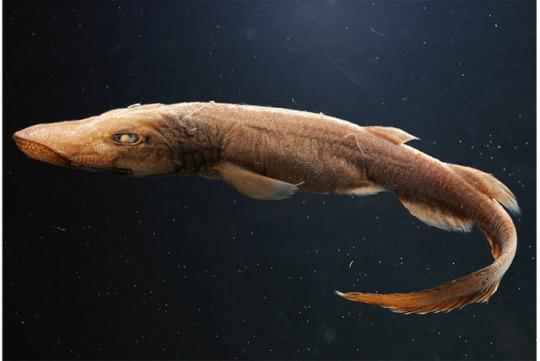
GATTUCCIO ABISSALE - Apristurus profundorum Isole Galapagos, Ecuador Fotografia di Norbert Wu, Minden Pictures, National Geographic Creative
3 notes
·
View notes
Text
Creature Feature: Iceland Catshark
Click to read about Taxonomy and this weeks Creature Feature!
Today we are going to talk about a species of shark that is a part of a very chaotic genus. If you have heard of the scientific concept “taxonomy” then you may know what a genus is. Taxonomy is the practice and science of classification. When looking at different sharks, scientists notice the way they look, where they live, and in recent years, their genetics to help classify them and put them…
View On WordPress
6 notes
·
View notes
Video
tumblr
Sharks are beautiful animals, and if you're lucky enough to see lots of them, that means that you're in a healthy ocean. You should be afraid if you are in the ocean and don't see sharks. —Sylvia Earle This #SharkWeek, we'd like to highlight the beauty and ecological significance of these captivating creatures. From the mighty great white to the tiny dwarf lantern shark, the diverse array of shark species play a pivotal role in many ocean ecosystems and help to support a healthy ocean. In the deep sea, we often come across this spectacular species—the longnose catshark, Apristurus kampae. These catsharks are found at depths ranging from 180 to 1,900 meters (about 600 to 6,300 feet). Catsharks are bottom feeders, often sleeping in groups during the day and hunting at night.
471 notes
·
View notes
Video
youtube
Meet the largest family of living sharks today—deep-sea catsharks.
Deep-sea catsharks are the largest family of living sharks today, with more than 90 species. Catsharks were named for their long, cat-like eyes that are specialized for seeing in low light conditions. These a-meow-zing sharks can be found up to 2,200 meters (7,200 feet) below the surface and grow up to 75 centimeters (30 inches).
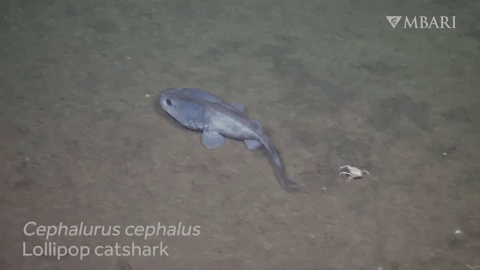
MBARI has observed several deep-sea catshark species, for example, the brown catshark (Apristurus brunneus), longnose catshark (Apristurus kampae), lollipop catshark (Cephalurus cephalus), and filetail catshark (Parmaturus xaniurus). Most catsharks lay elaborate clusters of egg cases. The eggs can take up to two years to develop. Tough egg cases, made of keratin protect the developing embryos from predators. A changing ocean means an uncertain future for catsharks. Warming waters could affect developing embryos, and expanding low-oxygen zones could displace adult populations.
150 notes
·
View notes
Video
tumblr
FaceTime with a catshark. 😻🦈
This is one of the three deep-sea catshark species found in the Northeast Pacific, the longnose catshark, Apristurus kampae. They are found at depths ranging from 180 to 1,888 meters (590 to 6,500 feet). Catsharks are bottom feeders, and are most active at night, often sleeping in groups during the day, and hunting at night.
60 notes
·
View notes
Text
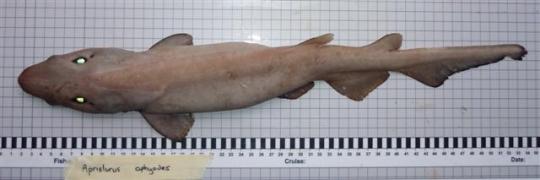
White ghost catshark | Apristurus aphyodes
Photo credit: x
28 notes
·
View notes
Text
Buying Guides, Reviews & Articles On New Innovation, Gizmos & Gadgets.
After that you most likely understand about hairballs, if you possess cat that sheds its own hair a lot or even possesses long hair. It holds true that at one factor wild animals needed to be recorded and stored against their will definitely in order for contemporary pets to exist, but that was 1000s of years back. You may certainly not need to have a pussy-cat home; you could just establish this for him to sleep on. When in usage so you are not paying out for this all the time, that just arrives on. Lots of people have a superstitious notion, if a black canine show up to your property door means you will certainly consult with your aged good friend and if the dog comes inside to your home, implies an aged friend is actually relating to your home. They adored books and could not communicate along with a canine that dealt with an amount of Shakespeare like a chew plaything, anymore than they could handle a kitty that honed its paws on Proust. I always consider Ernest Hemmingway's cats when I read about pussy-cats along with extra toes. Both cats have actually been actually kept as dogs, however some people from each varieties have actually come to be unsafe as grownups. Canines normally carry out outperform felines on many animal Intelligence Quotient examinations and also have larger vocabularies and also larger brains, but pet dog aficionados should not be actually too contented. For some folks having a kitty for a prolonged time period will definitely anesthetize all of them to the allergens of a certain pet cat. This post is "satire", seeking to utilize the exact same debates versus dog possession as people do versus unusual animal ownership. Many male pussy-cats present this behavior when they odor the genital areas or urine of a female cat in warm. What people aren't sure is actually that a pussy-cat needs to have behavior training just like high as dogs perform. Feline's are actually trainable in contrast to popular belief. A cheetah is going to occasionalyl search bunny, hogs, hare, birds and also various other little animals depending on the schedule from food in its atmosphere. The cats usually discuss their grassland habitation with caracals and might take on all of them for prey. You may use this on your ceramic tile and timber floors at the same time, that is actually all organic and also chemical free so that will not injure you or even your household pets. The Apristurus kampae types is a sort of catshark under the Scyliorhinidae household. Ocicats adore time4fit.info humans and commonly accept complete strangers conveniently. They are devoted animal aficionados who left her use disgusted due to the lies, deceit, and also fraud being carried out on unsuspecting donors and also advocates. Pet cats have 300 thousand nerve cells, while pets have simply 160 million, which means that pet cats have a better capability for data processing in comparison to pets.
The shade dressed fernery was actually originally installed to keep the sun off your house in the mid-day but was effortlessly converted to a compete the kitties through installing a gate at the southerly end (as seen in the picture's). I can't determine between felines and also pets so I reckon I refer each! Some foods like raisins and also grapes are actually the poisonous food for pet dogs, that can easily induce diarrhea, belly troubles, kidney failure as well as in some worst instances this might trigger causing intense renal breakdown as well as heart diseases.Also, there are solitary creatures the same as there are actually singular humans, it doesn't suggest the individual or animal is actually sociopathic considering that they are actually solitary. His device may be actually much more sensitive than other pet cats, suggesting he needs a longer time to obtain used to the new nosh.
0 notes